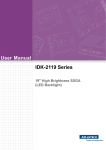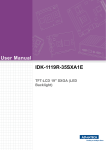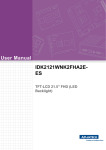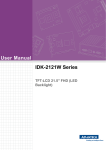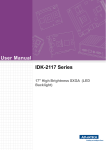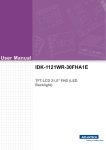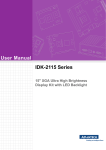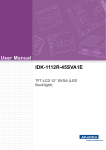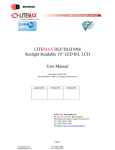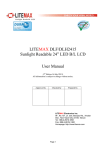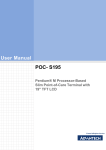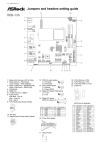Download User Manual IDK-2119 Series
Transcript
User Manual IDK-2119 Series 19" High Brightness SXGA LED-Backlight Display Copyright The documentation and software included with this product are copyrighted 2014 by Advantech Co., Ltd. All rights are reserved. Advantech Co., Ltd. reserves the right to improve the products described in this manual at any time without notice. No part of this manual may be reproduced, copied, translated or transmitted in any form or by any means without the prior written permission of Advantech Co., Ltd. Information provided in this manual is intended to be accurate and reliable. However, Advantech Co., Ltd. assumes no responsibility for its use, nor for any infringements of the rights of third parties that may result from its use. Acknowledgements AMI is a trademark of American Megatrends Inc. IBM and PC are trademarks of International Business Machines Corporation. Intel® Core 2 Quad, Pentium Dual-Core and Celeron are trademarks of Intel Corporation. WinBond is a trademark of Winbond Corporation. All other product names or trademarks are properties of their respective owners. IDK-2119 User Manual Part No. 2006211902 Edition 3 Printed in China August 2014 ii Message to the Customer Advantech Customer Services Each and every Advantech product is built to the most precise specifications to ensure reliable performance in the harsh and demanding conditions typical of industrial environments. Regardless of whether your new Advantech equipment is destined for a laboratory or factory floor, you can be assured that your product will provide the reliability and ease of operation for which Advantech has come to be known. Your satisfaction is our primary concern. To ensure you receive the full benefit of our services, please follow the instructions in this guide. Technical Support We want you to experience the maximum performance of your products. Should you encounter technical difficulties, we are available to provide assistance. Answers to the most frequently asked questions are provided in the product documentation. Generally, these answers are more detailed than the information we can offer over the telephone. So please consult this manual first. If you still cannot find the answer, gather all the information or questions that apply to your problem, and with the product close at hand, contact your dealer. Our dealers are well trained and ready to provide the support you need to get the most from your Advantech products. In fact, most of the problems reported are minor and easily resolved over the telephone. In addition, free technical support from Advantech engineers is available during business hours. We are always ready to offer advice regarding application requirements or to provide specific information related to the installation and operation of any of our products. iii IDK-2119 User Manual Product Warranty (2 years) Advantech warrants the original purchaser that all products will be free from defects in materials and workmanship for two years from the date of purchase. This warranty does not apply to products that have been repaired or altered by persons other than repair personnel authorized by Advantech, or products subject to misuse, abuse, accidents or improper installation. Advantech assumes no liability under the terms of this warranty as a consequence of such events. Because of Advantech’s high quality-control standards and rigorous testing, most of our customers never need to use our repair service. If an Advantech product is defective, it will be repaired or replaced at no charge during the warranty period. For outof-warranty repairs, customers are billed according to the cost of the replacement materials, service time and freight. Please consult your dealer for more details. If you believe your product to be defective, please follow the steps listed below: 1. Collect all information regarding the problem encountered. (For example, CPU speed, Advantech products involved, other hardware and software used, etc.) Note anything abnormal and list any onscreen messages you encounter when the problem occurs. 2. Call your dealer and describe the problem. Please have your manual, product number, and related information readily available. 3. If your product is diagnosed as defective, obtain an RMA (return merchandise authorization) number from your dealer. This allows us to process your return more quickly. 4. Carefully pack the defective product, a completed Repair and Replacement Order Card and a proof of purchase date (such as a photocopy of your sales receipt) in a shippable container. Products returned without a proof of purchase date will not be eligible for our warranty service. 5. Write the RMA number clearly on the outside of the packaging before shipping the product prepaid to your dealer. IDK-2119 User Manual iv Contents Chapter 1 Overview...............................................1 1.1 1.2 General Description .................................................................................. 2 Specifications ............................................................................................ 2 1.2.1 LCD Panel..................................................................................... 2 1.2.2 LED Driver Board.......................................................................... 2 1.2.3 Touch Screen (R series) ............................................................... 2 1.2.4 Environment.................................................................................. 2 Mechanical Characteristics ....................................................................... 3 1.3.1 IDK-2119N-K2SXA2E ................................................................... 3 1.3.2 IDK-2119R-K2SXA2E ................................................................... 5 Functional Block Diagram ......................................................................... 7 Figure 1.1 Functional block diagram............................................ 7 Touch Screen Driver ................................................................................. 7 Absolute Maximum Ratings ...................................................................... 7 1.6.1 Absolute Ratings for TFT LCD Module ......................................... 7 1.6.2 Absolute Ratings for Backlight Unit............................................... 7 1.6.3 Absolute Environmental Ratings................................................... 8 1.3 1.4 1.5 1.6 Chapter 2 Electrical Characteristics ...................9 2.1 Power Specifications............................................................................... 10 Table 2.1: Power Specifications ................................................ 10 Backlight Driving Conditions ................................................................... 10 Table 2.2: Backlight Driving Conditions..................................... 10 2.2 Chapter 3 Signal Characteristics .......................13 3.1 3.2 3.5 Pixel Format Image ................................................................................. 14 Pin Description ........................................................................................ 14 Table 3.1: Pin Description ......................................................... 14 Input Data Format ................................................................................... 16 Interface Timing ...................................................................................... 16 3.4.1 Timing Characteristics ................................................................ 16 Table 3.2: Timing Characteristics .............................................. 16 3.4.2 Input Timing Diagram.................................................................. 17 Power ON/OFF Sequence ...................................................................... 17 4 Connector & Pin Assignment ...........19 4.1 TFT LCD Module..................................................................................... 20 4.1.1 Connectors.................................................................................. 20 Table 4.1: Connectors ............................................................... 20 4.1.2 Pin Assignment ........................................................................... 20 Table 4.2: Pin Assignment......................................................... 20 Backlight Unit .......................................................................................... 20 4.2.1 Signal for LED Light Bar Connector............................................ 21 4.2.2 LED Driver Board........................................................................ 21 Table 4.3: Specifications ........................................................... 21 Table 4.4: Input Connector Pin Definition (CN4) ....................... 22 Table 4.5: Output Connector Pin Definition (CN1, CN2) ........... 22 Figure 4.1 Dimensions............................................................... 22 3.3 3.4 Chapter 4.2 v IDK-2119 User Manual Chapter 5 Touch Screen & Controller .............. 23 5.1 Touch Screen (Optional: for IDK-2119R only) ........................................ 24 5.1.1 Touch Characteristics ................................................................. 24 5.1.2 Optical Characteristics................................................................ 24 5.1.3 Environmental Characteristics .................................................... 24 5.1.4 Mechanical Characteristics......................................................... 24 5.1.5 Electronic Characteristics ........................................................... 24 5.1.6 General Specifications................................................................ 25 Touch Controller (Optional: for IDK-2119R only) .................................... 25 5.2.1 Touch Controller Characteristics ................................................ 25 5.2.2 Pin Assignment and Description................................................. 26 Figure 5.1 Board-mounted header ............................................ 27 5.2.3 Physical Dimensions................................................................... 28 5.2 Appendix A Optical Characteristics..................... 29 A.1 Optical Characteristics ............................................................................ 30 Table A.1: Optical Characteristics ............................................. 30 Appendix B Handling Precautions ....................... 33 B.1 Handling Precautions.............................................................................. 34 IDK-2119 User Manual vi Chapter 1 Overview 1 1.1 General Description The Advantech IDK-2119 series is equipped with a 19" 1200 cd/m2 industrial-grade LCD display and LED driver board. This series is also available with various touch screen options and enhancements, such as AR surface treatment and optical bonding solutions. The IDK-2119 series supports a high brightness of 1200 cd/m2 at the maximum power consumption of 29.61 W. Featuring a high level of brightness and wide operating temperature range, IDK-2119 provides superior sunlight readability and is ideal for both semi-outdoor and outdoor environments. 1.2 Specifications 1.2.1 LCD Panel Display Size: 19" LED backlight panel Resolution: 1280 x 1024 Viewing Angle (U / D / L / R): 80° / 80° / 85° / 85° Brightness: 1200 cd/m2 Contrast Ratio: 1100:1 Response Time (ms): 5 ms Colors: 16.7 M Voltage: 5 V Power Consumption: 32.67 W Signal Interface: 2 channel LVDS Weight: R series: 2800 (typical) N series: 1700 (typical) Dimensions (W x H x D): N series: 396 (H) x 324 (V) x 17.8 (D) (typical) R series: 396 (H) x 324 (V) x 21.7 (D) (typical) 1.2.2 LED Driver Board Efficiency: 92% Output Current & Voltage: 1600 mA / 19.8 V (typical) Dimensions (W x H x D): 80 x 54.2 x 16 mm 1.2.3 Touch Screen (R series) Touch Screen: 5-wire resistive Light Transmission: 80 3% Durability: 10 million times 1.2.4 Environment Operating Temperature: 0 ~ 50°C Storage Temperature: -20 ~ 60°C Humidity: 5 ~ 95% @ 40°C, non-condensing IDK-2119 User Manual 2 Chapter 1 1.3 Mechanical Characteristics 1.3.1 IDK-2119N-K2SXA2E Front View Overview 3 IDK-2119 User Manual Rear View IDK-2119 User Manual 4 Chapter 1 1.3.2 IDK-2119R-K2SXA2E Front View Overview 5 IDK-2119 User Manual Rear View IDK-2119 User Manual 6 Below is a functional block diagram of the 19-inch color TFT-LCD module. Chapter 1 1.4 Functional Block Diagram Overview Figure 1.1 Functional block diagram 1.5 Touch Screen Driver Please download the touch driver from www.advantech.com 1.6 Absolute Maximum Ratings The absolute maximum allowable ratings for this module are as follows: 1.6.1 Absolute Ratings for TFT LCD Module Item Symbol Min. Max. Unit Conditions Logic/LCD Drive Voltage VDD -0.3 +5.5 [Volt] Note 1, 2 1.6.2 Absolute Ratings for Backlight Unit Item Symbol Min. LED Light Bar Current ILed 800*2 7 Max. Unit Conditions [mA] Note 1, 2 IDK-2119 User Manual 1.6.3 Absolute Environmental Ratings Item Symbol Min. Max. Unit Operating Temperature TOP 0 +50 [oC] Operating Humidity HOP 8 90 [%RH] Storage Temperature TST -20 +60 [oC] Storage Humidity HST 8 90 [%RH] Conditions Note 1: Ta must not exceed 25°C Note 2: Permanent damage to the device may occur if the maximum values are exceeded. IDK-2119 User Manual 8 Chapter 2 Electrical Characteristics 2 2.1 Power Specifications The input power specifications are as follows: Table 2.1: Power Specifications Symbol Parameter Min. Typ. Max. Unit Condition VCC Logic/LCD Drive Voltage 4.5 5.0 5.5 [Volt] 10% ICC Input Current - 0.94 1.1 [A] Vin = 5.0 V; all white pattern; at 60 Hz PCC VCC Power - 4.7 5.5 [Watt] Vin = 5.0 V; all white pattern; at 60 Hz IRush Inrush Current - 2.1 2.5 [A] Note 1 Note 1: Measurement condition 2.2 Backlight Driving Conditions The parameter guideline of the LED light bar driver is 25°C (room temperature) at stable condition. Table 2.2: Backlight Driving Conditions Item Symbol Values Min. Typ. Unit Condition Max. LED Voltage VL - 19.2 V Notes 2, 3 LED Current IL - 670*2 mA Note 2 LED Lifetime - 50,000 - Hr Note 1 IDK-2119 User Manual - 10 Note 2: The LED driving condition is defined for each LED module (6 LED serial). Note 3: The variance in power consumed by the LED light bar is 10%. PLED is the calculated reference value (PLED = IL x VL x 2) Chapter 2 Note 1: The LED lifetime is defined as the time before the module brightness decreases to 50% of the original brightness when at an ambient temperature of 25°C, with a typical LED current of 800 mA. Electrical Characteristics 11 IDK-2119 User Manual IDK-2119 User Manual 12 Chapter 3 3 Signal Characteristics 3.1 Pixel Format Image The following figure shows the relationship between input signals and the LCD pixel format. 3.2 Pin Description The module uses a pair of LVDS-compatible SN75LVDS82 receivers (Texas Instruments). LVDS is a differential signaling technology developed for LCD interfaces and high-speed data transfer devices. Additionally, the device transmitters are SN75LVDS83 compatible (negative edge sampling). The first LVDS port (RxOxxx) transmits odd pixels and the second LVDS port (RxExxx) transmits even pixels. Table 3.1: Pin Description Pin No. Symbol Description 1 RxOIN0- Negative LVDS differential data input (odd data) 2 RxOIN0+ Positive LVDS differential data input (odd data) 3 RxOIN1- Negative LVDS differential data input (odd data) 4 RxOIN1+ Positive LVDS differential data input (odd data) 5 RxOIN2- Negative LVDS differential data input (odd data, H-Sync, V-Sync, DSPTMG) 6 RxOIN2+ Positive LVDS differential data input (odd data, H-Sync, V-Sync, DSPTMG) 7 VSS Power ground 8 RxOCLKIN- Negative LVDS differential clock input (odd clock) 9 RxOCLKIN+ Positive LVDS differential clock input (odd clock) 10 RxOIN3- Negative LVDS differential data input (odd data) 11 RxOIN3+ Positive LVDS differential data input (odd data) 12 RxEIN0- Negative LVDS differential data input (even data) 13 RxEIN0+ Positive LVDS differential data input (even data) 14 VSS Power ground IDK-2119 User Manual 14 RxEIN1- Negative LVDS differential data input (even data) 16 RxEIN1+ Positive LVDS differential data input (even data) 17 VSS Power ground 18 RxEIN2- Negative LVDS differential data input (even data) 19 RxEIN2+ Positive LVDS differential data input (even data) 20 RxECLKIN- Negative LVDS differential clock input (even clock) 21 RxECLKIN+ Positive LVDS differential clock input (even clock) 22 RxEIN3- Negative LVDS differential data input (even data) 23 RxEIN3+ Positive LVDS differential data input (even data) 24 VSS Power ground 25 VSS Power ground 26 NC No contact 27 VSS Power ground 28 VCC +5.0 V power supply 29 VCC +5.0 V power supply 30 VCC +5.0 V power supply 15 IDK-2119 User Manual Signal Characteristics 15 Chapter 3 Table 3.1: Pin Description 3.3 Input Data Format Note 1: Typically, DE mode only. VS and HS on the EVEN channel are not used. Note 2: Please follow VESA. Note 3: 8-bit input 3.4 Interface Timing 3.4.1 Timing Characteristics Table 3.2: Timing Characteristics Signal Item Symbol Min. Typ. Max. Unit Period TV 1032 1066 1150 TH Active Tdisp(V) 1024 1024 1024 TH Blanking Tbp(V)+Tfp(V)+PWVS 8 42 126 TH Period TH 780 844 2047 TClock Active Tdisp(H) 640 640 640 TClock Blanking Tbp(H)+Tfp(H)+PWHS 140 204 - TClock Period TClock 22.2 18.52 14.81 ns Frequency Freq 45 54 67.5 MHz Frame Rate Frequency 1/TV 50 60 75 Hz Vertical Section Horizontal Section Clock Note 1: DE mode IDK-2119 User Manual 16 Chapter 3 3.4.2 Input Timing Diagram Signal Characteristics 3.5 Power ON/OFF Sequence The VDD power and lamp ON/OFF sequence, in addition to the interface signals, are shown below. Signals from any system should be in Hi-Z state or at a low level when the VDD is off. 17 IDK-2119 User Manual Power Sequence Timing Parameter Value Unit Min. Typ. Max. T1 0.5 - 10 [ms] T2 30 40 50 [ms] T3 175 - - [ms] T4 10 - - [ms] T5 10 - - [ms] T6 0 - - [ms] T7 10 - - [ms] T8 100 - - [ms] T9 0 16 50 [ms] T10 T11 IDK-2119 User Manual [ms] 1000 [ms] 18 Chapter 4 Connector & Pin Assignment 4 4.1 TFT LCD Module The physical interface of the connectors on the TFT LCD module are described in this section. The components and signals accommodated by these connectors are as follows: 4.1.1 Connectors Table 4.1: Connectors Connector Name / Description Interface Connector / Interface Card Manufacturer JAE / P-TWO Type / Part Number FI-XB30SSLA-HF15 / 187034-30091 Mating Housing Part Number FI-X30HL FI-X30H (unlocked type) 4.1.2 Pin Assignment Table 4.2: Pin Assignment Pin No. Signal Name Pin No. Signal Name 1 RxOIN0- 2 RxOIN0+ 3 RxOIN1- 4 RxOIN1+ 5 RxOIN2- 6 RxOIN2+ 7 VSS 8 RxOCLKIN- 9 RxOCLKIN+ 10 RxOIN3- 11 RxOIN3+ 12 RxEIN0- 13 RxEIN0+ 14 VSS 15 RxEIN1- 16 RxEIN1+ 17 VSS 18 RxEIN2- 19 RxEIN2+ 20 RxECLKIN- 21 RxECLKIN+ 22 RxEIN3- 23 RxEIN3+ 24 VSS 25 VSS 26 NC 27 VSS 28 VCC 29 VCC 30 VCC 4.2 Backlight Unit The physical interface of the backlight unit is as described for the connectors on the module. The components and signals accommodated are as follow: IDK-2119 User Manual 20 Connector No. Pin No. Upper Lower CN1 CN2 Input Color Function 1 HI 1 Red Power supply for backlight unit 2 GND 1 Black Ground for backlight unit 1 HI 2 Red Power supply for backlight unit 2 GND 2 Black Ground for backlight unit 4.2.2 LED Driver Board Connector Name / Description LED driver board input connector Manufacturer JST Connector Model Number BH6B-PH or equivalent Adaptable Plug PHR-6 or equivalent 4.2.2.1 Specifications Table 4.3: Specifications Symbol Characteristics Condition Voltage Efficiency Input Typ. Max. Unit 12 13.2 V Vin = 12 V Iout = 800 mA Vout = 19.2 V Power Output Min. 10.8 92 3 ON/OFF W 18 24 V Current 150 1500 mA 10 % Current Accuracy 150 mA Iout 1000 mA 5 Thermal / OVP Thermal Shutdown PWM Dimmer 30 Voltage Protection Environment % 165 Operating Junction Temperature °C 125 °C Operating Temperature -20 +70 °C Storage Temperature -40 + 85 °C Dimmer Range (Note 1) 5 100 V Dimmer VH 2 5 V Dimmer VL 0 1.5 V Dimmer Frequency 0.25 1 KHz Von 3.5 5.5 V Off 0 2 V 21 0.5 IDK-2119 User Manual Connector & Pin Assignment Cable Length: 250 mm+ / -10 mm Chapter 4 4.2.1 Signal for LED Light Bar Connector 4.2.2.2 Input Connector Pin Definition Table 4.4: Input Connector Pin Definition (CN4) Pin No. Pin Definition 1 Vin (+12 V) 2 Vin (+12 V) 3 GND 4 GND 5 ON/OFF (0V: Off; +5 V: On) 6 Dimming (PWM) 4.2.2.3 Output Connector Pin Definition Table 4.5: Output Connector Pin Definition (CN1, CN2) Pin No. Pin Definition 1 VLED- 2 VLED+ 4.2.2.4 Dimensions Figure 4.1 Dimensions IDK-2119 User Manual 22 Chapter 5 Touch Screen & Controller 5 5.1 Touch Screen (Optional: for IDK-2119R only) 5.1.1 Touch Characteristics The touch panel features a resistive-type touch screen for use with flat LCD displays. When touched, using either a round-ended resin pen or finger, the touch panel circuit identifies the touch coordinates based on the voltage at the point of contact on the screen. 5.1.2 Optical Characteristics Item Specification Remarks 1 Transparency 80% 3% BYK-Gardner 2 Haze 8.0% 3% BYK-Gardner 5.1.3 Environmental Characteristics Item Specification Remarks 1 Operating Temperature -20 ~ 70°C 2 Storage Temperature -40 ~ 80°C Note: All terms under an atmosphere of 1 3 Operating Humidity 20 ~ 80%RH 4 Storage Humidity 20 ~ 90%RH 5.1.4 Mechanical Characteristics Item Specification Remarks 1 Surface Hardness Pencil hardness 3H. JIS K-5600-5-4 150gf, 45° 2 FPC Peeling Strength 1) 5N (5N min.) 2) 19.6N (19.6N min.) 1) Peeling upward by 90° 2) Peeling downward by 90° 3 Operating Force Pen Dot spacer Within the guaranteed active area, but not on the age resistor or dot spacer. Finger 0.05N ~ 1.96N (5 ~ 200gf) 5.1.5 Electronic Characteristics Item Specification 1 Rated Voltage DC 7 V max. 2 Resistance Remarks X axis: 200 ~ 500 (see figure below) FPC connector Y axis: 200 ~ 800(see figure below) 3 Linearity X 1.5% (see figure below) Y 1.5% (see figure below) 4 Chattering 15ms max. 5 Insulation Resistance 20M min. (DC 25 V) IDK-2119 User Manual 24 Reference: 250 gf Chapter 5 Item Specification 1 Frame Size 393.40 0.50 x 316.650.50 mm 2 Viewing Area 380.90 0.20 x 305.65 0.20 mm 3 Active Area 377.300.20 x 302.05 0.20 mm 4 Total Thickness 3.20 0.20 mm 5 Tail Length 305.0 6.0 mm 5.2 Touch Controller (Optional: for IDK-2119R only) The Advantech ETM-RES04C Touch Control Board is the ultimate combo board. This touch panel controller enables the optimum performance of analog-resistive touch panels for 5-wire models. The controller communicates with the PC system directly through USB and RS-232 connector. This design delivers superior sensitivity, accuracy and ease of operation. The touch panel driver emulates the left and right button functions of a mouse and has the following features: 5.2.1 Touch Controller Characteristics 5.2.1.1 Specifications Electrical Features +5 Vdc/ 100 mA typical, 50 mV peak-to-peak maximum ripple and noise Bi-directional RS-232 serial communication and full speed USB 1.1 Maximum report rate is 180 points/sec for RS-232, and 200 points/sec for USB Unaffected by environmental EMI. The 5-wire model panel resistance is 50 ~ 200 ohm (pin to pin on same layer) Touch resistance under 3K ohm 25 IDK-2119 User Manual Touch Screen & Controller 5.1.6 General Specifications Serial Interface EIA 232E (Serial RS-232) No parity, 8 data bits, 1 stop bit, 9600 baud (N, 8, 1, 9600) Supports Windows 2000 / Vista / XP/ 7, Windows CE 5.0 / 6.0 / 7.0, Windows NT4, Linux, DOS and QNX USB Interface Conforms to full-speed USB, Revision 1.1. If the USB is connected to the controller, the controller will communicate via the USB not the serial port. Supports Windows 2000/ Vista / XP / 7, Windows CE 5.0 / 6.0 / 7.0, Linux and QNX Touch Screen Resolution Resolution is 2,048 x 2,048 Response Time Max. 20 ms 5.2.1.2 Environmental Features Reliability MTBF is 200,000 hours Temperature Ranges Operating temperature is -25 ~ 85°C Storage temperature is -25 ~ 85°C Relative Humidity Relative humidity is 95% at 60°C, non-condensing RoHS certificate complete Regulatory FCC-B and CE approvals complete Dimensions: 75 mm x 20 mm x 10 mm 5.2.2 Pin Assignment and Description 5.2.2.1 Connector and LED Locations JP1 Connector (USB & RS-232 combo interface) JP2 Connector (5-wire touch screen interface) LED IDK-2119 User Manual 26 Signal Name Signal Function RS-232 Pin # Signal Name Signal Function 1 2 G Ground 1 G Ground V USB Power 2 V Power 3 G Ground 3 G Ground 4 D+ USB D+ 4 TxD Serial port 5 D- USB D- 5 RxD Serial port Signal Name DB-9 pin # RS-232 pin # Sourced By Signal Description RxD 2 5 Ctlr Serial data from controller to host TxD 3 4 Host Serial data from host to controller Figure 5.1 Board-mounted header 5.2.2.3 JP2 Touch Screen Connector Pins and Signal Descriptions The JP2 touch screen connector is a single row, 2.54 mm, 5-pin, 90°, male-type connector. The pins are numbered as shown in the following table. JP2 Pin # Signal Name Signal Description 1 H / UR Drive signal attached to the upper right corner of the touch screen substrate (from the user's perspective). 2 Y / UL Drive signal attached to the upper left corner of the substrate. 3 COM - 4 X / LR Drive signal attached to the lower right corner of the substrate. 5 L / LL Drive signal attached to the lower left corner of the substrate. 27 IDK-2119 User Manual Touch Screen & Controller USB Pin # Chapter 5 5.2.2.2 JP1 Combo Interface Connector Pins and Signal Descriptions The combo interface connector, USB and RS-232, is a box, 2.0 mm, 10-pin, 90°, male-type lock connector developed for use with single-wire pins in a 5+5 pin header. The pins are numbered as shown in the following table. 5.2.3 Physical Dimensions ETM-RES04C-EEH4EE Touch Control Board (unit: mm) IDK-2119 User Manual 28 Appendix A A Optical Characteristics A.1 Optical Characteristics The following optical characteristics are as measured when in stable condition at a room temperature of 25°C: Table A.1: Optical Characteristics Item Unit Viewing Angle [degree] Luminance Uniformity [%] Optical Response Time [msec] Color / Chromaticity Coordinates (CIE 1931) Conditions Min. Typ. Max. Note Horizontal (right) 85 - CR = 10 (left) 85 - Vertical (up) 80 - CR = 10 (down) 80 - 9 points 75 85 - Rising - 3.6 5.7 Falling - 1.4 2.3 Rising and falling - 5 8 White x - 0.2582 - White y - 0.2614 - Color Temp. K - 6500 - White Luminance [cd/m2] 1100 1200 - - 1100 - Contrast Ratio 1 2, 3 5 4 4 Optical equipment: BM-7, DT-101, or equivalent Note 1: The viewing angle is defined as the contrast ratio ®R10 at the screen center over a 180° horizontal and 180° vertical range (off-normal viewing angles). The 180° viewing angle range is 90° ) horizontally left and right, and 90° () vertically high (up) and low (down). The angle is typically measured from the center of the screen and perpendicular to the display surface when rotating the screen to develop the desired viewing angle. Note 2: The nine-point position 90 % 50 % 10 % 10 % 50 % 90 % IDK-2119 User Manual 30 Minimum Brightness of nine points W9 = Maximum Brightness of nine points Note 4: Regarding the measurement method, the LCD module should be stabilized at a set temperature for 30 minutes to avoid abrupt changes in temperature when measuring. To stabilize the luminance, measurement should be conducted in a dark windowless room after the backlight has been activated for 30 minutes and using DT-100, or an equivalent, as the optical equipment. Note 5: Regarding the response time, the photo detector output signals are measured when the input signals are changed from “Full Black” to “Full White” (rising time), and from “Full White” to “Full Black” (falling time). The response time is defined as the interval between the 10% and 90% amplitude points. Please refer to the figure below. % Tf Tr 100 90 Optical White Black White response 10 0 31 IDK-2119 User Manual Appendix A Optical Characteristics Note 3: The luminance uniformity of the nine points can be determined by dividing the maximum luminance values by the minimum test point luminance IDK-2119 User Manual 32 Appendix B B Handling Precautions B.1 Handling Precautions 1. Because the front polarizer is vulnerable to damage, we recommend taking additional care not to scratch the polarizer surface. 2. Be sure to turn off the power supply when connecting/disconnecting from the input connector. 3. In the event of exposure to water or other liquids, immediately wipe off all liquid droplets. Prolonged contact with liquid may cause discoloration or spots. 4. To clean the panel surface, wipe with an absorbent cotton or soft cloth. 5. Because the panel is made of glass, it is liable to break or crack if dropped or hit with a hard object. 6. As CMOS LSI is used in this module, be cautious of static electricity and ensure human earthing when handling. 7. Do not open or modify the module assembly. 8. Do not bend the reflector sheet at the back of the module in any direction. 9. To reinsert the module into the packing container slot, lightly press the far edges of the LED light bar reflector; otherwise the TFT module may be damaged. 10. When inserting or removing the signal interface connector, do not rotate or tilt the interface connector on the TFT module. 11. After installing the TFT module in an enclosure, do not twist nor bend the TFT module. When designing such enclosures, avoid bending or twisting the TFT module to prevent damage. 12. A small amount of material with no flammability grading has been used in the LCD module. The LCD module should be supplied with power that satisfies the requirements of a limited power source (IEC60950 or UL1950); otherwise an exemption must be obtained. IDK-2119 User Manual 34 www.advantech.com Please verify specifications before quoting. This guide is intended for reference purposes only. All product specifications are subject to change without notice. No part of this publication may be reproduced in any form or by any means, electronic, photocopying, recording or otherwise, without prior written permission of the publisher. All brand and product names are trademarks or registered trademarks of their respective companies. © Advantech Co., Ltd. 2014









































